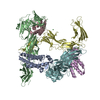[English] 日本語
 Yorodumi
Yorodumi- PDB-8avd: Cryo-EM structure for a 3:3 complex between mouse leptin and the ... -
+ Open data
Open data
- Basic information
Basic information
| Entry | Database: PDB / ID: 8avd | ||||||
|---|---|---|---|---|---|---|---|
| Title | Cryo-EM structure for a 3:3 complex between mouse leptin and the mouse LEP-R ectodomain (local refinement) | ||||||
 Components Components |
| ||||||
 Keywords Keywords | CYTOKINE / leptin / LEP-R / obesity / metabolism / energy balance | ||||||
| Function / homology |  Function and homology information Function and homology informationSynthesis, secretion, and deacylation of Ghrelin / leptin receptor activity / regulation of transport / regulation of lipoprotein lipid oxidation / cellular response to L-ascorbic acid / positive regulation of fat cell apoptotic process / negative regulation of glutamine transport / negative regulation of appetite by leptin-mediated signaling pathway / Synthesis, secretion, and inactivation of Glucagon-like Peptide-1 (GLP-1) / negative regulation of glucagon secretion ...Synthesis, secretion, and deacylation of Ghrelin / leptin receptor activity / regulation of transport / regulation of lipoprotein lipid oxidation / cellular response to L-ascorbic acid / positive regulation of fat cell apoptotic process / negative regulation of glutamine transport / negative regulation of appetite by leptin-mediated signaling pathway / Synthesis, secretion, and inactivation of Glucagon-like Peptide-1 (GLP-1) / negative regulation of glucagon secretion / regulation of endothelial cell proliferation / regulation of natural killer cell proliferation / regulation of natural killer cell mediated cytotoxicity / leptin receptor binding / regulation of bone remodeling / positive regulation of luteinizing hormone secretion / bone growth / regulation of natural killer cell activation / glycerol biosynthetic process / regulation of steroid biosynthetic process / elastin metabolic process / leptin-mediated signaling pathway / positive regulation of follicle-stimulating hormone secretion / positive regulation of monoatomic ion transport / regulation of intestinal cholesterol absorption / positive regulation of hepatic stellate cell activation / regulation of feeding behavior / regulation of brown fat cell differentiation / positive regulation of peroxisome proliferator activated receptor signaling pathway / regulation of nitric-oxide synthase activity / adult feeding behavior / activation of protein kinase C activity / bone mineralization involved in bone maturation / regulation of lipid biosynthetic process / sexual reproduction / response to leptin / negative regulation of cartilage development / ovulation from ovarian follicle / negative regulation of D-glucose import / negative regulation of appetite / positive regulation of developmental growth / energy reserve metabolic process / leukocyte tethering or rolling / cellular response to leptin stimulus / bile acid metabolic process / prostaglandin secretion / cardiac muscle hypertrophy / positive regulation of p38MAPK cascade / hormone metabolic process / cell surface receptor signaling pathway via STAT / regulation of protein localization to nucleus / regulation of fat cell differentiation / intestinal absorption / eating behavior / insulin secretion / regulation of metabolic process / aorta development / regulation of gluconeogenesis / negative regulation of vasoconstriction / response to vitamin E / glycogen metabolic process / peptide hormone receptor binding / fatty acid beta-oxidation / regulation of cytokine production involved in inflammatory response / central nervous system neuron development / response to dietary excess / peptide hormone binding / T cell differentiation / negative regulation of lipid storage / positive regulation of TOR signaling / regulation of angiogenesis / cell surface receptor signaling pathway via JAK-STAT / negative regulation of gluconeogenesis / positive regulation of insulin receptor signaling pathway / adipose tissue development / phagocytosis / glial cell proliferation / cholesterol metabolic process / energy homeostasis / cellular response to retinoic acid / positive regulation of T cell proliferation / positive regulation of interleukin-12 production / regulation of insulin secretion / negative regulation of autophagy / placenta development / response to activity / gluconeogenesis / determination of adult lifespan / positive regulation of interleukin-8 production / positive regulation of receptor signaling pathway via JAK-STAT / female pregnancy / response to insulin / circadian rhythm / hormone activity / positive regulation of interleukin-6 production / positive regulation of protein import into nucleus / lipid metabolic process / regulation of blood pressure / glucose metabolic process / cellular response to insulin stimulus Similarity search - Function | ||||||
| Biological species |  | ||||||
| Method | ELECTRON MICROSCOPY / single particle reconstruction / cryo EM / Resolution: 4.42 Å | ||||||
 Authors Authors | Verstraete, K. / Savvides, S.N. / Verschueren, K.G. / Tsirigotaki, A. | ||||||
| Funding support |  Belgium, 1items Belgium, 1items
| ||||||
 Citation Citation |  Journal: Nat Struct Mol Biol / Year: 2023 Journal: Nat Struct Mol Biol / Year: 2023Title: Mechanism of receptor assembly via the pleiotropic adipokine Leptin. Authors: Alexandra Tsirigotaki / Ann Dansercoer / Koen H G Verschueren / Iva Marković / Christoph Pollmann / Maximillian Hafer / Jan Felix / Catherine Birck / Wouter Van Putte / Dominiek Catteeuw / ...Authors: Alexandra Tsirigotaki / Ann Dansercoer / Koen H G Verschueren / Iva Marković / Christoph Pollmann / Maximillian Hafer / Jan Felix / Catherine Birck / Wouter Van Putte / Dominiek Catteeuw / Jan Tavernier / J Fernando Bazan / Jacob Piehler / Savvas N Savvides / Kenneth Verstraete /     Abstract: The adipokine Leptin activates its receptor LEP-R in the hypothalamus to regulate body weight and exerts additional pleiotropic functions in immunity, fertility and cancer. However, the structure and ...The adipokine Leptin activates its receptor LEP-R in the hypothalamus to regulate body weight and exerts additional pleiotropic functions in immunity, fertility and cancer. However, the structure and mechanism of Leptin-mediated LEP-R assemblies has remained unclear. Intriguingly, the signaling-competent isoform of LEP-R is only lowly abundant amid several inactive short LEP-R isoforms contributing to a mechanistic conundrum. Here we show by X-ray crystallography and cryo-EM that, in contrast to long-standing paradigms, Leptin induces type I cytokine receptor assemblies featuring 3:3 stoichiometry and demonstrate such Leptin-induced trimerization of LEP-R on living cells via single-molecule microscopy. In mediating these assemblies, Leptin undergoes drastic restructuring that activates its site III for binding to the Ig domain of an adjacent LEP-R. These interactions are abolished by mutations linked to obesity. Collectively, our study provides the structural and mechanistic framework for how evolutionarily conserved Leptin:LEP-R assemblies with 3:3 stoichiometry can engage distinct LEP-R isoforms to achieve signaling. | ||||||
| History |
|
- Structure visualization
Structure visualization
| Structure viewer | Molecule:  Molmil Molmil Jmol/JSmol Jmol/JSmol |
|---|
- Downloads & links
Downloads & links
- Download
Download
| PDBx/mmCIF format |  8avd.cif.gz 8avd.cif.gz | 405.7 KB | Display |  PDBx/mmCIF format PDBx/mmCIF format |
|---|---|---|---|---|
| PDB format |  pdb8avd.ent.gz pdb8avd.ent.gz | 290.3 KB | Display |  PDB format PDB format |
| PDBx/mmJSON format |  8avd.json.gz 8avd.json.gz | Tree view |  PDBx/mmJSON format PDBx/mmJSON format | |
| Others |  Other downloads Other downloads |
-Validation report
| Summary document |  8avd_validation.pdf.gz 8avd_validation.pdf.gz | 1.4 MB | Display |  wwPDB validaton report wwPDB validaton report |
|---|---|---|---|---|
| Full document |  8avd_full_validation.pdf.gz 8avd_full_validation.pdf.gz | 1.4 MB | Display | |
| Data in XML |  8avd_validation.xml.gz 8avd_validation.xml.gz | 59.1 KB | Display | |
| Data in CIF |  8avd_validation.cif.gz 8avd_validation.cif.gz | 87.2 KB | Display | |
| Arichive directory |  https://data.pdbj.org/pub/pdb/validation_reports/av/8avd https://data.pdbj.org/pub/pdb/validation_reports/av/8avd ftp://data.pdbj.org/pub/pdb/validation_reports/av/8avd ftp://data.pdbj.org/pub/pdb/validation_reports/av/8avd | HTTPS FTP |
-Related structure data
| Related structure data |  15679MC  7z3pC  7z3qC  7z3rC  8av2C  8avbC  8avcC  8aveC  8avfC  8avoC  8b7qC C: citing same article ( M: map data used to model this data |
|---|---|
| Similar structure data | Similarity search - Function & homology  F&H Search F&H Search |
- Links
Links
- Assembly
Assembly
| Deposited unit | 
|
|---|---|
| 1 |
|
- Components
Components
| #1: Protein | Mass: 18873.283 Da / Num. of mol.: 3 Source method: isolated from a genetically manipulated source Details: Mouse leptin was produced with an N-terminal His-tag and refolded from inclusion bodies produced in E. coli Source: (gene. exp.)   #2: Protein | Mass: 97479.391 Da / Num. of mol.: 3 Source method: isolated from a genetically manipulated source Details: The mLEP-R ectodomain was C-terminally fused to a trimeric GCN4 isoleucine zipper tag and secreted from HEK93 FreeStyle cells and complexed with refolded mouse leptin produced in E.coli. Source: (gene. exp.)   Homo sapiens (human) / Variant (production host): FreeStyle / References: UniProt: P48356 Homo sapiens (human) / Variant (production host): FreeStyle / References: UniProt: P48356#3: Chemical | Has ligand of interest | N | Has protein modification | Y | |
|---|
-Experimental details
-Experiment
| Experiment | Method: ELECTRON MICROSCOPY |
|---|---|
| EM experiment | Aggregation state: PARTICLE / 3D reconstruction method: single particle reconstruction |
- Sample preparation
Sample preparation
| Component | Name: Stucture of mouse leptin in complex with a trimerized form of the mouse Lep-R extracellular region Type: COMPLEX Details: The mLEP-R ectodomain was C-terminally fused to a trimeric GCN4 isoleucine zipper tag and secreted from HEK93 FreeStyle cells and complexed with refolded mouse leptin produced in E.coli. Entity ID: #1-#2 / Source: RECOMBINANT | |||||||||||||||
|---|---|---|---|---|---|---|---|---|---|---|---|---|---|---|---|---|
| Molecular weight | Value: 0.444 MDa / Experimental value: YES | |||||||||||||||
| Source (natural) | Organism:  | |||||||||||||||
| Source (recombinant) | Organism:  Homo sapiens (human) / Strain: 293 Freestyle / Plasmid: pTwist Homo sapiens (human) / Strain: 293 Freestyle / Plasmid: pTwist | |||||||||||||||
| Buffer solution | pH: 7.4 / Details: 20 mM HEPES, 150 mM NaCl, pH 7.4 | |||||||||||||||
| Buffer component |
| |||||||||||||||
| Specimen | Conc.: 0.3 mg/ml / Embedding applied: NO / Shadowing applied: NO / Staining applied: NO / Vitrification applied: YES / Details: This sample was monodisperse. | |||||||||||||||
| Specimen support | Grid material: COPPER / Grid mesh size: 300 divisions/in. / Grid type: C-flat-1.2/1.3 | |||||||||||||||
| Vitrification | Instrument: LEICA EM GP / Cryogen name: ETHANE / Humidity: 99 % / Chamber temperature: 295 K |
- Electron microscopy imaging
Electron microscopy imaging
| Experimental equipment |  Model: Titan Krios / Image courtesy: FEI Company |
|---|---|
| Microscopy | Model: TFS KRIOS |
| Electron gun | Electron source:  FIELD EMISSION GUN / Accelerating voltage: 300 kV / Illumination mode: FLOOD BEAM FIELD EMISSION GUN / Accelerating voltage: 300 kV / Illumination mode: FLOOD BEAM |
| Electron lens | Mode: OTHER / Nominal magnification: 105000 X / Nominal defocus max: 2500 nm / Nominal defocus min: 1200 nm / Cs: 2.7 mm |
| Image recording | Electron dose: 45 e/Å2 / Film or detector model: GATAN K3 BIOQUANTUM (6k x 4k) / Num. of grids imaged: 1 / Num. of real images: 13230 |
- Processing
Processing
| Software |
| |||||||||||||||||||||||||||||||||||||||||||||
|---|---|---|---|---|---|---|---|---|---|---|---|---|---|---|---|---|---|---|---|---|---|---|---|---|---|---|---|---|---|---|---|---|---|---|---|---|---|---|---|---|---|---|---|---|---|---|
| EM software |
| |||||||||||||||||||||||||||||||||||||||||||||
| CTF correction | Type: PHASE FLIPPING AND AMPLITUDE CORRECTION | |||||||||||||||||||||||||||||||||||||||||||||
| Particle selection | Num. of particles selected: 141157 | |||||||||||||||||||||||||||||||||||||||||||||
| Symmetry | Point symmetry: C1 (asymmetric) | |||||||||||||||||||||||||||||||||||||||||||||
| 3D reconstruction | Resolution: 4.42 Å / Resolution method: FSC 0.143 CUT-OFF / Num. of particles: 54708 Details: The final map was obtained via local refinement in cryoSPARC using a mask around the mouse leptin:LEP-R core region of the trimeric complex Symmetry type: POINT | |||||||||||||||||||||||||||||||||||||||||||||
| Atomic model building | Protocol: FLEXIBLE FIT / Space: REAL | |||||||||||||||||||||||||||||||||||||||||||||
| Atomic model building | PDB-ID: 7Z3R Accession code: 7Z3R / Source name: PDB / Type: experimental model | |||||||||||||||||||||||||||||||||||||||||||||
| Refinement | Cross valid method: NONE Stereochemistry target values: GeoStd + Monomer Library + CDL v1.2 | |||||||||||||||||||||||||||||||||||||||||||||
| Displacement parameters | Biso mean: 240.44 Å2 | |||||||||||||||||||||||||||||||||||||||||||||
| Refine LS restraints |
|
 Movie
Movie Controller
Controller








 PDBj
PDBj






